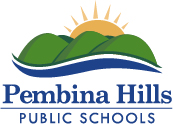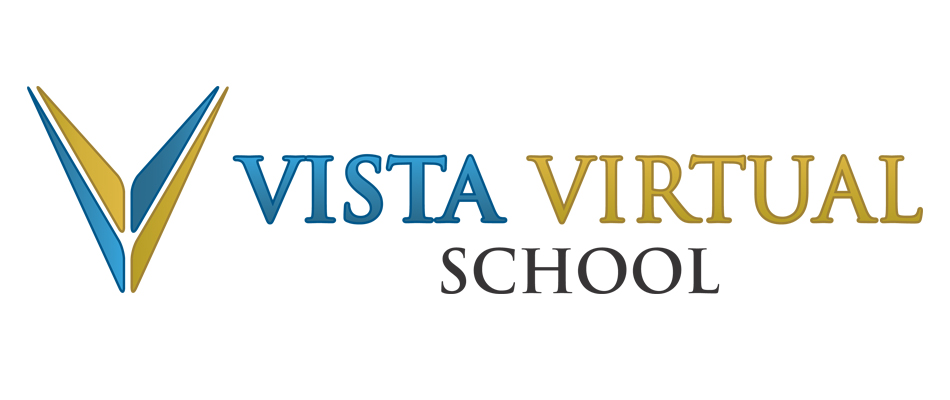September 2021 Newsletter
August 31st, 2021
Click each article below to read this month’s newsletter or read the PDF version.
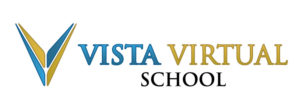
Learning Without Limits
Welcome back! We hope you had a wonderful summer break and that you’re all refreshed and ready to hit the books! For those of you who are new to Vista Virtual School, we welcome you and wish you the absolute best in your endeavours. And for those of you who are back with us, we are delighted that you’ve once again chosen VVS for your educational journey.
Our fall semester kicks off today, and things are, well, as normal as they can ever be amid the ongoing pandemic. Our support staff are back at our our Calgary campus. Diploma exams are back on schedule for November—you can read more about these further on in this newsletter. For the time being, however, in-person field trips and student-parent-teacher interviews remain a no-go as COVID numbers are still far from where we would like to see them.
The new school year brings some staffing changes, which you can also read about later on here, including new academic counsellors for the year. You can read all about our new teachers and support staff in the staff bios section of the VVS website.
As always, we welcome your comments and feedback regarding this newsletter, or anything else. If you have any questions or concerns, please phone us toll-free at 1-855-974-5333 or talk with your teacher. If you have any VVS-related stories you’d like to share (including student success stories), please contact Ben Freeland, our communications and marketing specialist.
We wish you a wonderful 2021-2022 school year!
Sincerely,
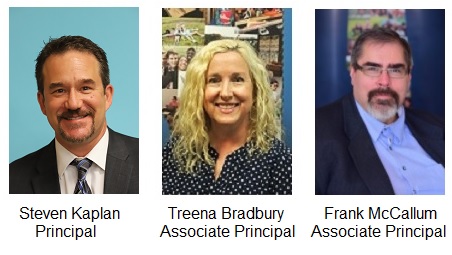
Meet Our New Teachers!
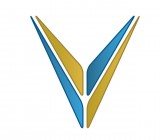 Vista Virtual School is pleased to welcome 11 new teachers to our faculty this year. These include three new elementary teachers, five new high school teachers, two new Academic Counsellors, and two new Special Education instructors. You can read their bios on our website.
Vista Virtual School is pleased to welcome 11 new teachers to our faculty this year. These include three new elementary teachers, five new high school teachers, two new Academic Counsellors, and two new Special Education instructors. You can read their bios on our website.
Taking over from Dominick Gallo and Andrea Robin this year in the Academic Counsellor roles are VVS newcomers Jessica Luciuk and Loya De Clercq. Jessica will be responsible for students from grades 1 to 9, while Loya will take care of grades 10 to 12. Moving into the Special Education roles are Christie Borle and newcomer Vanessa Mathison.
Joining us at the elementary level are Margareta Hinrichsen, Christine Quong, and Jake Warkentin—Jake in the role of Department Head. At the high school level, we welcome humanities teachers Isabel Rempel and Patrick Fountain as well as science instructors Alejandro Acevedo, Helen Hampton, and Angela Viola.
Welcome aboard!
Congratulations to our Citizenship Award Winners!

VVS is proud to announce that we have five winners for this year’s Pembina Hills School Division Citizenship Awards! Please join us in congratulating Caitlin West (grade 7), Jonathan Tang (grade 7), Mark Stewart (grade 7), Zairyn Mierau (grade 7), and Caitlin R. (grade 10) on their achievement!
You can read all about these five students and the standout contributions they have made to their communities, as well as those of students elsewhere in the division, at PHSD online. Congratulations Caitlin, Jonathan, Mark, Zairyn and Caitlin—you’ve made us proud!
School Year Timeline
Key dates for the coming school year are as follows:
- Grades 1-9: September 1, 2021 to June 15, 2022
- Grades 10-12, first semester: September 1, 2021 to January 15, 2022
- Deadline for 2021-2022 registration: September 17
- Deadline for submitting first semester assignments: January 15, 2022
- Grades 10-12, second semester: February 1 to June 15, 2022
- Deadline for submitting second semester assignments: June 15, 2022
- Summer school: dates TBD
- Open entry for adults and international students
Student Expectations
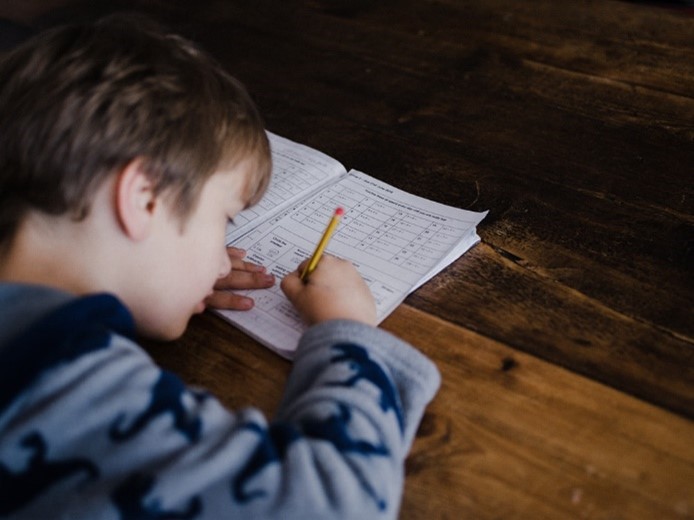 Vista Virtual School’s high school program operates on a semester system, following the traditional school year. All assignments for the first semester must be submitted prior to January 15 so that grades can be finalized by January 31. High school students are also expected to complete a short E-Learning and Learning Management Systems course (COM1255) by the end of September.
Vista Virtual School’s high school program operates on a semester system, following the traditional school year. All assignments for the first semester must be submitted prior to January 15 so that grades can be finalized by January 31. High school students are also expected to complete a short E-Learning and Learning Management Systems course (COM1255) by the end of September.
Elementary and junior high students should submit all assignments by June 15, 2022 at the latest so that grades can be finalized by June 28.
Successful students are committed, responsible, and able to work well with teacher direction and independently as required. As such, all students are expected to work regularly, submitting assignments according to the timelines provided and asking their teachers for assistance when needed.
Students who do not submit work in September and October put their continued registration in jeopardy. As a general rule, students should expect to put in at least 30 hours of work on their studies every week.
New Orientation Video
Are you new to Vista Virtual School? If so, you will definitely want to watch this 2021-2022 orientation video hosted by associate principal Frank McCallum. Even if you have previous experience with virtual learning—as many now have thanks to COVID—VVS will invariably be quite different from what you are used to if you are new to the school, and this video will be extremely helpful to you.
Topics covered include: textbook fees and pick-up, what VVS courses are like, teacher correspondence and availability, how to navigate coursework, COMM 1255 (e-learning course), planning your academic year, tips for success in distance learning, important dates, diploma exams, and upcoming Q&A sessions.
AHS Back-to-School Checklist and Immunizations
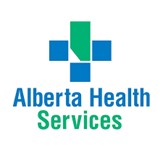 Ready for back-to-school time? Have you consulted Alberta Health Services’ online back-to-school health checklist? With COVID-19 continuing to dominate health headlines globally, it’s easy to forget about all the other health-related to-do’s, which include making sure all emergency contact numbers for parents and physicians are kept up to date. This handy checklist makes it easy.
Ready for back-to-school time? Have you consulted Alberta Health Services’ online back-to-school health checklist? With COVID-19 continuing to dominate health headlines globally, it’s easy to forget about all the other health-related to-do’s, which include making sure all emergency contact numbers for parents and physicians are kept up to date. This handy checklist makes it easy.
Speaking of routine health matters, AHS is, as always, providing routine immunizations—typically for children in grades 1, 6, and 9. More information is available through AHS or your local Community Health Centre.
Diploma Exams
Alberta Education has announced the dates for the 2021-2022 Diploma Exams. The next round of exams will be held between Thursday, October 28 and Wednesday, November 10. The regular Alberta government Diploma Exam page has yet to be updated, but this online bulletin outlines the year’s exam dates.
Diploma exams MUST be written in person. VVS will be overseeing exams at testing centres in both Calgary and Edmonton. If you do not live in either the Calgary or Edmonton areas, you have the option of writing diploma exams at your local school, should they be able to facilitate this and provide supervision. If they cannot, you will have to travel to either Calgary or Edmonton for these exams.
If you have any questions about diploma exams, please contact vv.main@pembinahills.ca.
Alberta Education Survey
Do you, like many Albertans, have concerns about the government of Alberta’s draft K-6 curriculum? If so, we encourage you to complete the government’s online survey on the draft curriculum, which will remain open until the spring of 2022. You can further make your voice heard by writing a letter to your MLA, the education minister, and/or the premier expressing your concerns about the draft curriculum and other issues facing our educational system amid the pandemic.
Textbook Returns
We are still accepting textbook returns from the 2020-2021 school year at our Calgary campus. Please note that students/parents are responsible for postage for mailed returns. Please return textbooks and other loaned materials, either by mail or in person (by appointment), to the following address:
Vista Virtual School
341 58 Avenue SE
Calgary, AB T2H 0P3
Please note that as we have recently moved our warehouse from Barrhead to Calgary, refunds for books returned this summer are delayed until the start of September. We sincerely apologize for this delay.
Visiting VVS Campus
Support staff are now back at VVS’ Calgary Campus and will be responding to calls at 1-855-974-5333 x5317 and emails at vvsupport@pembinahills.ca. Visitors to the campus are still requested to book appointments in advance, whether it is for returning textbooks or for any other reason. Those wishing to visit are expected to book an appointment in advance, follow all Alberta Health Services guidelines, and, to everyone safe, we ask visitors to wear a mask.
Accessing the Student Information System (SIS)
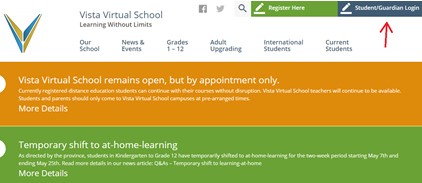 Parents and guardians who have not yet logged into the VVS Student Information System (SIS) should do so as soon as possible, as this is the best way to monitor your child’s progress, review correspondence, keep track of course timelines, and stay up to date with your child’s activities and submissions. You should have received an email providing you with login information for your account.
Parents and guardians who have not yet logged into the VVS Student Information System (SIS) should do so as soon as possible, as this is the best way to monitor your child’s progress, review correspondence, keep track of course timelines, and stay up to date with your child’s activities and submissions. You should have received an email providing you with login information for your account.
To get started, visit the school website and click on the Student/Guardian Login button in the top right hand corner to be directed to the SIS login page. If you have forgotten your username and/or password, you can retrieve them by submitting your email address.
You can also contact us at vvsupport@pembinahills.ca or by phone at 1-855-974-5333 x5317 if you have any trouble.
Adult Learning at Vista Virtual School
Vista Virtual School welcomes applications from adult upgrading students—defined as those aged 20 or up as of September 1, 2021—throughout the year; adult students can start courses at any time. For more information on our adult program, please visit our website or email us at vvsadults@pembinahills.ca.
School Council and Parent Input
Although we do not have a formal School Council, we welcome parents, guardians, and students to provide input on the operations of the school. Please direct your suggestions to Principal Steven Kaplan.
Student Success Stories
Our VVS student community is always scaling new heights in a myriad pursuits, from athletics to the arts to community citizenship, that it’s practically impossible to keep up. Nevertheless, we do love to profile some of our standouts in this newsletter. If you know of a VVS student (or you ARE one) who has recently accomplished something major or is involved in something unique, we would love to hear from you.
Please direct all messages regarding our student success story columns to newsletter editor Ben Freeland at ben.freeland@pembinahills.ca.
Engage With Us on Social Media
 In addition to this newsletter and our regular website news postings, Vista Virtual School is also active on Facebook and Twitter. We encourage you to follow us for updates on everything from post-secondary orientations to work experience opportunities to news articles and online resources of interest to students and parents, as well as to just say hello and engage with us.
In addition to this newsletter and our regular website news postings, Vista Virtual School is also active on Facebook and Twitter. We encourage you to follow us for updates on everything from post-secondary orientations to work experience opportunities to news articles and online resources of interest to students and parents, as well as to just say hello and engage with us.
Also, should you come across any interesting virtual learning resources you think we should share via our social media networks, we would love to hear from you. We too are always learning, and we would love to share what you find out there.
Monthly Events Calendar
Check out our monthly events on our website. We update this calendar as events are added.
Important Dates in September
Why We Wear Orange on September 30
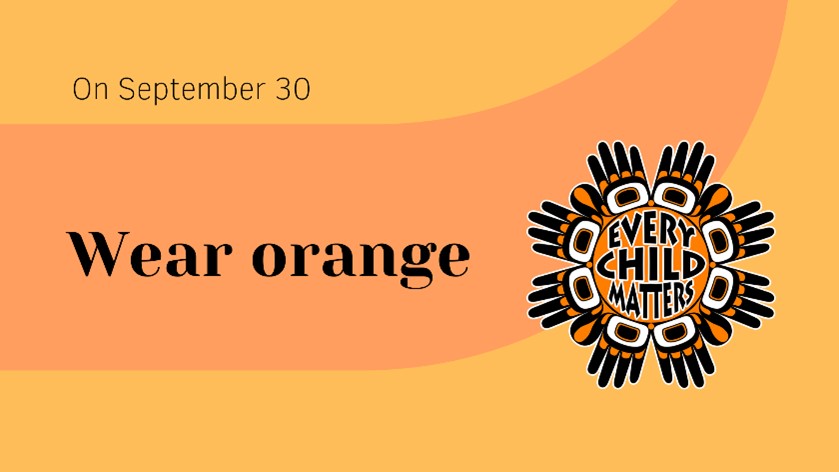 If there was ever a year to wear orange on September 30, then this is it. 2021 has been a truly harrowing year for the survivors of Canada’s residential school system and their families—and for Indigenous Canadians generally—starting in May of this year with the discovery of the remains of at least 215 children in unmarked graves at the site of the Kamloops Indian Residential School in British Columbia, followed by subsequent discoveries of similar graves in Saskatchewan.
If there was ever a year to wear orange on September 30, then this is it. 2021 has been a truly harrowing year for the survivors of Canada’s residential school system and their families—and for Indigenous Canadians generally—starting in May of this year with the discovery of the remains of at least 215 children in unmarked graves at the site of the Kamloops Indian Residential School in British Columbia, followed by subsequent discoveries of similar graves in Saskatchewan.
For millions of Canadians, these grisly discoveries were a sobering reminder that, a full five years after the dissolution of Canada’s Truth and Reconciliation Commission and the tabling of the TRC’s calls to action, the healing process surrounding this dark chapter of Canadian history has barely begun.
Residential School Facts at a Glance
A recent poll showed that half of Albertans know “little” about the residential school system, while a full 20 percent claim to know “nothing at all” about it. This fact in mind, it is worthwhile revisiting some of the key facts about this chapter of our history as a reminder of why it remains such a consequential issue.
- The residential school system operated for nearly 150 years, from 1863 until the last school closed in 1997.
- The schools operated in every province and territory except for New Brunswick and Prince Edward Island.
- More than 150,000 Indigenous children were taken from their families and placed in these schools. Schools were typically situated in very remote locations so as to discourage parental visits.
- Attendance was compulsory and enforced for Indigenous children aged seven to 16 from 1894 until 1948; thereafter financial incentives remained in place to coerce parents into continuing to have their students attend.
- Student deaths ranged between at least 3,201 (the official TRC count) and as many as 6,000 (according to some estimates), giving residential school students a higher mortality rate than Canada’s fighting forces in World War II. In the vast majority of cases, parents were not informed of their children’s deaths.
- Tuberculosis, a disease correlated with malnutrition and poor protection from the elements, was the primary killer of children at these schools. An Alberta physician in the 1920s on an inspection of a school in what is now Maskwacis, AB reported that at least 50 percent of children were afflicted with the disease.
- At least 90 percent of students were subjected to some sort of physical, emotional or sexual abuse. Corporal punishment was standard practice to deter children from speaking their native languages or practicing Indigenous customs.
- In some cases, students were subjected to medical experiments without their consent (or that of their parents). These included vaccine trials and even nutritional experiments, in which children were deliberately starved.
- The TRC estimates that some 80,000 survivors of residential school system remain, many of whom continue to suffer from wide-ranging emotional trauma.
- The Canadian government formally apologized for the system in 2008. Several churches with past involvement in it have apologized as well, although the Catholic church, which oversaw 70 percent of the schools, has yet to do so.
Why an Orange Shirt?
The choice of orange shirts as a symbol of recognition of the abuses suffered in the residential schools hearkens to the story of survivor Phyllis Webstad. As a six-year-old child, Phyllis was traumatized by her teachers when she was forced to strip for wearing a bright orange shirt to school. She has since published two books, Orange Shirt Story and Phyllis’ Orange Shirt—both aimed at younger children, and to this day she works to raise awareness of the system and its innumerable abuses.
The date of September 30 was chosen because late September was typically the time of year when Indigenous children were rounded up from their communities to be taking away to residential schools. The event began as a reunion of former students of the St. Joseph Mission (SJM) Residential School in Williams Lake, BC in 2013. The movement has grown steadily since then, and is now a national movement, with the federal government, several provinces (including Alberta), and a number of churches having made it official.
What Can We Do?
The Alberta government now officially recognizes Orange Shirt Day. In addition to asking Albertans to wear orange on this day, the GoA website also urges people to:
- Share photos on social media
- Organize an online or in-person event (following Alberta Health guidelines)
- Read about the legacy of residential schools
- Read the summary of the Final Report of the Truth and Reconciliation Commission of Canada
- Find and watch films online about people’s experiences at residential schools
- Spend time learning about Indigenous cultures
Don’t have an orange shirt? If so, the organization behind the event sells orange “Every Child Matters” T-shirts on their online store. The site also has the full story of Phyllis Webstad and the movement that is now bringing justice to generations of people who were dehumanized. At VVS we look forward to seeing you in orange on September 30. It’s the least any of us can do.
A Bit of Virtual Learning History
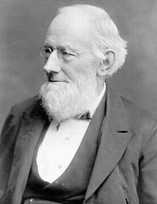 Vista Virtual School may have only been around for 25 years, and the type of learning provided here has only been made possible by recent technological innovations, but the idea of distance learning has been around for much longer than this. In fact, the first well documented instance of learning by correspondence dates back to 1844, although this too was only made possible by recent (at that time) inventions.
Vista Virtual School may have only been around for 25 years, and the type of learning provided here has only been made possible by recent technological innovations, but the idea of distance learning has been around for much longer than this. In fact, the first well documented instance of learning by correspondence dates back to 1844, although this too was only made possible by recent (at that time) inventions.
Sir Isaac Pitman was a teacher and educational innovator who revolutionized shorthand—a now little used but once invaluable form of rapid writing prior to the advent of recording devices. Pitman is also credited by many as the inventor of correspondence learning, as he would teach shorthand by who mailing texts transcribed into shorthand on postcards and receiving transcriptions from his students in return for correction, beginning in 1844.
Pitman’s scheme would never have worked had it not been for the establishment of a centralized postal system in the UK in 1840, which for the first time made postage accessible to the average citizen. His teaching system was also aided by a rapidly expanding British rail network, which allowed for relatively prompt communication between teacher and students. The system was extremely successful and led to the establishment of Sir Isaac Pitman Colleges across the country in the following decade.
Shortly thereafter, the University of London began offering the world’s first postsecondary correspondence courses through its “external program”. Chartered by Queen Victoria in 1858, the system was lauded by none other than novelist Charles Dickens, who called it the “People’s University”, for its accessibility to lower economic classes. The system still exists today as the University of London International Program.
Interestingly, COVID-19 is not the first serious disease to trigger advances in distance learning. In 1937, a polio outbreak in the city of Chicago led to the first large-scale use of radio for distance education, in which the city’s elementary school students were given instruction via radio broadcast. The first totally online educational offering came in 1984 courtesy of the University of Toronto, which offered an online course entitled “Women and Computers in Education”. The first fully online university, Spain’s Open University of Catalonia, was founded in 1994—two years prior to the establishment of VVS.
Something to think about as you start your school year.
Contacts


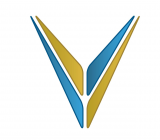
 Vista Virtual School is pleased to welcome 11 new teachers to our faculty this year. These include three new elementary teachers, five new high school teachers, two new Academic Counsellors, and two new Special Education instructors. You can read their bios on our website.
Vista Virtual School is pleased to welcome 11 new teachers to our faculty this year. These include three new elementary teachers, five new high school teachers, two new Academic Counsellors, and two new Special Education instructors. You can read their bios on our website.
 Vista Virtual School’s high school program operates on a semester system, following the traditional school year. All assignments for the first semester must be submitted prior to January 15 so that grades can be finalized by January 31. High school students are also expected to complete a short E-Learning and Learning Management Systems course (COM1255) by the end of September.
Vista Virtual School’s high school program operates on a semester system, following the traditional school year. All assignments for the first semester must be submitted prior to January 15 so that grades can be finalized by January 31. High school students are also expected to complete a short E-Learning and Learning Management Systems course (COM1255) by the end of September. Ready for back-to-school time? Have you consulted Alberta Health Services’ online
Ready for back-to-school time? Have you consulted Alberta Health Services’ online  Parents and guardians who have not yet logged into the VVS Student Information System (SIS) should do so as soon as possible, as this is the best way to monitor your child’s progress, review correspondence, keep track of course timelines, and stay up to date with your child’s activities and submissions. You should have received an email providing you with login information for your account.
Parents and guardians who have not yet logged into the VVS Student Information System (SIS) should do so as soon as possible, as this is the best way to monitor your child’s progress, review correspondence, keep track of course timelines, and stay up to date with your child’s activities and submissions. You should have received an email providing you with login information for your account. In addition to this newsletter and our regular website news postings, Vista Virtual School is also active on
In addition to this newsletter and our regular website news postings, Vista Virtual School is also active on  If there was ever a year to wear orange on September 30, then this is it. 2021 has been a truly harrowing year for the survivors of Canada’s residential school system and their families—and for Indigenous Canadians generally—starting in May of this year with the discovery of the remains of at least 215 children in unmarked graves at the site of the Kamloops Indian Residential School in British Columbia, followed by subsequent discoveries of similar graves in Saskatchewan.
If there was ever a year to wear orange on September 30, then this is it. 2021 has been a truly harrowing year for the survivors of Canada’s residential school system and their families—and for Indigenous Canadians generally—starting in May of this year with the discovery of the remains of at least 215 children in unmarked graves at the site of the Kamloops Indian Residential School in British Columbia, followed by subsequent discoveries of similar graves in Saskatchewan. Vista Virtual School may have only been around for 25 years, and the type of learning provided here has only been made possible by recent technological innovations, but the idea of distance learning has been around for much longer than this. In fact, the first well documented instance of learning by correspondence dates back to 1844, although this too was only made possible by recent (at that time) inventions.
Vista Virtual School may have only been around for 25 years, and the type of learning provided here has only been made possible by recent technological innovations, but the idea of distance learning has been around for much longer than this. In fact, the first well documented instance of learning by correspondence dates back to 1844, although this too was only made possible by recent (at that time) inventions.